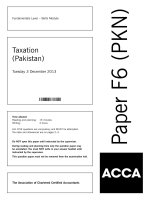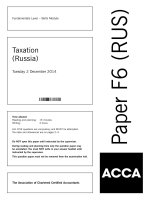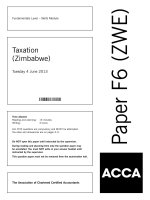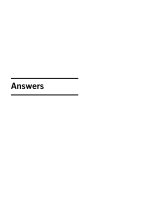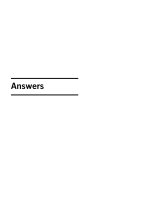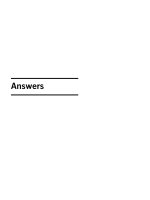ACCA f6 taxation zimbabwe 2013 dec answer
Bạn đang xem bản rút gọn của tài liệu. Xem và tải ngay bản đầy đủ của tài liệu tại đây (145.11 KB, 7 trang )
Answers
Fundamentals Level – Skills Module, Paper F6 (ZWE)
Taxation (Zimbabwe)
December 2013 Answers
and Marking Scheme
Marks
1
Moira Demo
(a)
(i)
Breached ZIMRA requirements
Employees tax (PAYE) registration requirements:
Moira Demo should have registered for PAYE within 14 days of becoming an employer and remitted the
employees tax deducted on the 10th of every month.
1½
Corporate tax registration requirements:
Moira Demo should have registered for corporate tax on the commencement of her business operations
and remitted the tax on the due quarterly payment dates (QPDs).
(ii)
Possible consequences of the breach of ZIMRA requirements (as in (i) above)
ZIMRA can backdate both the employees tax (PAYE) and corporate tax registration to the date when the
business operations commenced. All the outstanding tax returns will have to be submitted and the taxes
due paid.
ZIMRA can impose a penalty of 100% of the overdue tax, as well as charge interest of 10% p.a.
(b)
Moira Demo can also eliminate the risk of possible tax penalties and interest by submitting all her tax returns
on the due dates, as well as paying the requisite taxes on or before the due dates.
1
–––
2
–––
1
1
–––
2
–––
Compare and contrast the tax treatment of the representation allowances
From the Ministry of Health and Child Welfare: The whole amount is exempt from tax since Moira Demo is
in the civil service.
From Sight Restoration: As this is from a private organisation, the whole amount is subject to tax and will be
included in her taxable income.
(d)
1
Tax planning
Moira Demo can maximise the capital allowances available in respect of her business assets by electing to
claim the 25% special initial allowances on the qualifying assets instead of settling for wear and tear
allowances.
(c)
1½
–––
3
–––
(i)
1
–––
2
–––
NSSA contributions for the year ended 31 December 2012
Calculated at 3% of U$200 per month (3% x 200 x 12) = US$72 for the year.
(ii)
1
1
–––
PAYE (employees tax) for private practice for the year ended 31 December 2012
US$
60 000
15 000
10 000
4 000
0
5 000
(3 000)
3 600
–––––––
94 600
–––––––
–––––––
42 570
1 277
–––––––
43 847
–––––––
–––––––
Salary
School fees benefit
Home security benefit
Gym subscriptions benefit
South Africa trip – exempt
Utility bills benefit
RAF contributions
Motor vehicle benefit
Taxable income
Tax at the marginal rate of tax (45% x 94 600)
AIDs levy (3% x 42 570)
Total PAYE
19
½
½
½
½
1
½
½
½
1
½
–––
6
–––
Marks
(iii) Taxable income and tax payable for the year ended 31 December 2012
Salary from Ministry of Health
On call allowance
Accommodation allowance – exempt
Transport allowance – exempt
Bonus (2 500 – 700)
Representation allowance – exempt
Cash in lieu of leave
Employee pension contribution
NSSA contribution (from (d)(i) above)
Loan repayment – disallowed
Loan benefit on amount used to sink borehole: (6 000 x 7·5% x 6/12)
Subscription to professional association
Life policy stop order – disallowed
Taxable income from private practice (from (d)(ii) above)
Salary from Sight Restoration
Attendance allowance
Representation allowance
Total taxable income
Tax on sliding scale:
Up to US$120 000
(179 803 – 120 000) x 45%
38 100
26 911
––––––––
65 011
(6 000)
––––––––
59 011
1 770
––––––––
60 781
(33 930)
––––––––
26 851
––––––––
––––––––
Gross tax
Less: medical credit (8 000 + 4 000) x 50%
Add: 3% AIDS levy
Less: PAYE (14 000 + 19 930)
Tax payable
2
US$
30 000
12 000
0
0
1 800
0
2 500
(2 250)
(72)
0
225
(2 000)
0
94 600
16 000
20 000
7 000
––––––––
179 803
––––––––
––––––––
½
½
½
½
1
½
½
½
1
½
2
½
½
½
½
½
½
½
1
½
1
–––
14
–––
30
–––
Absolute Milling Company (Private) Limited (AMC)
(a)
Tax obligations in respect of the transfer of assets
The transfer of the fixed assets and the stock will be treated as deemed sales.
1
AMC is obliged to account for capital gains tax on the transfer of the immovable properties. The capital gains
tax should be remitted to ZIMRA within three working days of the date of accrual of the sale proceeds.
2
AMC should account for value added tax (VAT) on the transferred stock (where applicable). The transaction
should be included in AMC’s VAT return for the month of transfer and the VAT paid to ZIMRA by the 25th
day of the following month.
2
The deemed sale of stock should also be included in AMC’s gross income for the year.
(b)
1
–––
6
–––
Underpaid provisional corporate tax for the year ended 31 December 2012
US$
480 000
(45 000)
––––––––
435 000
––––––––
––––––––
112 013
(50 000)
––––––––
62 013
––––––––
––––––––
Projected taxable income
Less: assessed losses brought forward
Adjusted taxable income
Tax (including AIDS levy) at 25·75%
Less: tax paid
Corporate tax underpaid
20
½
½
½
½
–––
2
–––
Marks
(c)
Capital gains tax payable for the year ended 31 December 2012
Deemed gross proceeds at market value:
US$
400 000
300 000
430 000
320 000
––––––––––
1 450 000
––––––––––
––––––––––
Town milling buildings
Town warehouses
Harare No. 1 milling building
Harare No. 1 warehouse
Total gross proceeds
Capital gains tax at 5%
(d)
72 500
––––––––––
––––––––––
1
–––
3
–––
Taxable income and tax payable for the year ended 31 December 2012
Profit before tax
Add:
Sales value of transferred stock (375 000 + 500 000)
Hire of milling plant
Motor vehicle expenses
Vehicle licence penalty
Replacement of a vehicle trailer
Staff costs
PAYE on arrears of salaries
PAYE penalty
Software upgrade
Allowance for receivables
Depreciation
Disposal cost of the milling plant
Disposal cost of the milling building and warehouse (43 000 + 32 000)
General entertainment
Management staff share scheme
Finance costs on trade payables
Finance costs on long-term borrowings
Recoupment on fixed assets
Less:
Profit on sale of assets
Capital allowances:
Vehicle trailer (25% x 118 000)
Office building (2·5% x 200 000)
Commercial vehicles (25% x 150 000)
Assessed losses brought forward
Taxable income
Corporate tax (including AIDS levy) at 25·75%
Less: provisional tax paid
Tax payable
3
½
½
½
½
US$
560 000
875 000
0
0
7 000
118 000
0
0
47 250
0
40 000
44 000
0
75 000
42 000
40 000
0
60 000
1 200 000
1
½
½
½
½
½
½
½
½
½
½
½
½
½
1
½
½
1
(260 000)
½
(29 500)
(5 000)
(37 500)
(45 000)
––––––––––
2 731 250
––––––––––
––––––––––
703 297
(50 000)
––––––––––
653 297
––––––––––
––––––––––
½
½
½
½
½
½
–––
14
–––
25
–––
Billy Wells
(a)
Definition of a principal private residence (PPR)
For capital gains purposes, a PPR is a building used by the taxpayer as a sole residence situated in
Zimbabwe. It includes all ancillary buildings and structures associated with a domestic dwelling and a
registered piece of land of not more than two hectares surrounding the residence and used for domestic
purposes.
2
The PPR must have been the taxpayer’s main or sole residence with the taxpayer ordinarily staying at the
property during the period of ownership for at least four years before the disposal date or any other period
approved by ZIMRA.
1
21
Marks
Only one residence is considered as a PPR in the case of a taxpayer owning more than one such property
and the residence must have been the taxpayer’s main dwelling place.
The taxpayer’s sole or main residence will continue to be their PPR, even if the taxpayer has been prevented
from residing at the property due to employment commitments or such other circumstances as approved by
ZIMRA.
(b)
ZIMRA’s disallowance of the rollover claim is justifiable in that in this case, the partially developed residential
plot does not qualify as a PPR.
1
Although an undeveloped residential property if held for the purposes of being developed into a PPR
ordinarily qualifies as a PPR, it cannot qualify as a PPR if it is disposed of without the key improvements
which enable the property to be a dwelling being in place.
1
US$
15 000
150
1 500
The withholding tax is the final tax in the case of the quoted shares.
½
½
½
½
The withholding tax is not the final tax in the case of either the immovable property
or the unquoted shares.
½
½
–––
3
–––
Capital gains tax on the disposal of the unquoted shares
US$
30 000
Sale proceeds
Less:
Cost
Inflation allowance (2·5% x 20 000 x 4)
5% disposal expenses
20 000
2 000
1 500
–––––––
Capital gain
Capital gains tax at 20%
Less: withholding tax paid
(23 500)
–––––––
6 500
–––––––
–––––––
1 300
(1 500)
–––––––
200
–––––––
–––––––
Amount refundable
4
1
–––
3
–––
Capital gains withholding tax
Asset
Immovable property: 15% of the sale proceeds of US$100 000
Quoted shares: 1% of the sale proceeds of US$15 000
Unquoted shares: 5% of the sale proceeds of US$30 000
(d)
1
–––
5
–––
Rollover disallowance
Rollover relief also does not apply in instances where land or the improvements associated with a residential
property are disposed of separately from the actual dwelling house.
(c)
1
½
½
1
½
½
½
½
–––
4
–––
15
–––
Tom Veld
(a)
Tax registration
Tom Veld is obliged to register for value added tax (VAT) since his sales for the year are above the minimum
threshold of US$60 000.
1
His taxable supplies are subject to VAT at the rate of 0% due to the nature of his business.
½
Tom is also required to register for corporate tax and remit the tax in line with the quarterly payment dates
(QPDs).
½
Tom is not under an obligation to register for employees tax (PAYE) since his employees’ wages are all below
the taxable threshold of US$250 per month.
Tutorial note: Tom might be required to register for PAYE if he, himself, is in receipt of a salary or benefits
from his business operations, but the question does not indicate that this is the case.
22
1
–––
3
–––
Marks
(b)
Pre-trading expenditure
Tom Veld can claim relief on the pre-trading expenditure incurred before 1 February 2012 since the amounts
were incurred within the minimum period of 18 months before commencement of the trade.
(c)
(i)
Special deductions for the year ended 31 December 2012
US$
8 000
25 000
15 000
30 000
24 000
5 000
––––––––
107 000
––––––––
––––––––
Temporary farm roads
Farm and pasture fencing
Clearing and land preparation
Dam construction
Sinking of boreholes and wells
Contour ridges
(ii)
1
–––
½
½
½
½
½
½
–––
3
–––
Closing livestock value at 31 December 2012
Calves (20 x 200)
Steers (15 x 380)
Heifers (25 x 380)
Dairy cows (valued at purchase price)
Bulls (valued at purchase price)
US$
4 000
5 700
9 500
48 000
2 000
–––––––
69 200
–––––––
–––––––
)
½
)
–––
2
–––
US$
460 000
69 200
½
½
½
½
½
(iii) Minimum taxable income and tax payable for the year ended 31 December 2012
Farm revenue
Closing stock (from (c)(ii) above)
Less:
Purchases of livestock
Special deductions (from (c)(i) above)
Wages (10 000 + 28 000 + 45 000)
Animal feed supplement
Other running expenses
SIA on:
Dip tanks (25% x 18 000)
Borehole equipment (25% x 14 000)
Staff houses (25% x 10 000 x 6)
(69
(107
(83
(26
(80
Taxable income
Tax payable (including AIDS levy) at 25·75%
5
000)
000)
000)
000)
000)
½
½
½
½
½
(4 500)
(3 500)
(15 000)
––––––––
141 200
––––––––
––––––––
½
½
1
36 359
––––––––
––––––––
½
–––
6
–––
15
–––
Rhino Printers Limited (RPL)
(a)
Value added tax (VAT) on transferred stock
As a registered operator, RPL is obliged to account for output tax on the stock transferred to their subsidiary,
Rhino Booksellers (Private) Limited (RB).
½
The output tax should be included in RPL’s VAT return for the period and the tax remitted to ZIMRA by the
25th of the month following the end of the period.
1
The output tax to be accounted for by RPL is (15/115 x 200 000) = US$26 087
23
½
–––
2
–––
Marks
(b)
VAT payable by/refundable to RB for the year ended 31 December 2012
Output tax (15/115 x 118 000)
Less:
Input tax on:
Transferred stock (equivalent to (a) above)
Repairs and maintenance (15/115 x 23 000)
Staff costs
Rental expenses
Loan establishment fee
Other general expenses (15/115 x 18 000)
Refundable amount
(c)
(i)
US$
15 391
½
(26 087)
(3 000)
0
0
0
(2 348)
–––––––
16 044
–––––––
–––––––
1
½
½
1
1
½
–––
5
–––
VAT deregistration
A registered operator can deregister either on the cessation of trade or when the operator is no longer
making taxable supplies.
1
A registered operator can also deregister:
–
–
when their turnover falls below the annual minimum threshold of US$60 000; or
in the case of an operator who was voluntarily registered, when they can no longer meet the set
conditions.
The registered operator is required to notify ZIMRA in writing within 21 days of a cessation of trade.
(ii)
½
½
1
–––
3
–––
RB’s VAT deregistration
Although RB’s sales for the months of June to December 2012 are below the monthly threshold of
US$5 000, their annual turnover is still well above the minimum threshold of US$60 000.
Therefore, deregistration is only possible by reference to the winding up of RB. Since a resolution was
passed for RB to cease operations on 10 January 2013, its VAT deregistration will take effect from that
date.
1
1
–––
2
–––
(iii) VAT to be accounted for on closing stock
RB must account for VAT on the closing stock held at the date of deregistration on which input tax has
previously been claimed.
1
The VAT payable to ZIMRA will be as follows:
Sales value of closing stock: (121 070 x 1·3)
US$
157 391
––––––––
Output tax to be accounted for (15% x 157 391)
23 609
––––––––
24
1
1
–––
3
–––
15
–––

